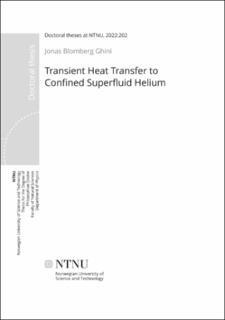| dc.contributor.advisor | Sudbø, Asle | |
| dc.contributor.advisor | Auchmann, Bernhard | |
| dc.contributor.advisor | Baudouy, Bertrand | |
| dc.contributor.author | Ghini, Jonas Blomberg | |
| dc.date.accessioned | 2022-06-16T06:06:43Z | |
| dc.date.available | 2022-06-16T06:06:43Z | |
| dc.date.issued | 2022 | |
| dc.identifier.isbn | 978-82-326-6765-9 | |
| dc.identifier.issn | 2703-8084 | |
| dc.identifier.uri | https://hdl.handle.net/11250/2998977 | |
| dc.description.abstract | To investigate how the Large Hadron Collider at CERN can survive UFO attacks much larger than expected, we build and perform an experiment designed to measure the transient temperature evolution of both a stainless steel heater subjected to millisecond time-scale losses and the confined helium cooling this heater.
In the first paper we focus on a configuration where the heater is cooled by an open bath of superfluid helium. Setup validation is done by fitting the Kapitza heat transfer expression to steady state measurements, finding fit parameters within the expected range. We do not find conclusive evidence of an orientation dependence of the Kapitza heat transfer mechanism, nor heat transfer differences that can be attributed to local surface variations along the same heater. The setup shows critical heat flux in line with estimates from literature, and the time between a step in heating and the onset of film boiling follows the expected behaviour.
During the first millisecond after a step in applied heating power density our measurements show a slower thermal rise time than that found by a time-dependent one-dimensional model of our setup using the steady state Kapitza heat transfer expression as the cooling boundary condition. After the first millisecond, agreement between measurement and model is excellent.
In the second paper we confine the helium near the heater to a channel of 120 μm depth. The helium is isolated from the external bath with the exception of two pin-holes that, on the time-scale of tens of milliseconds, allow only negligible heat exchange with the external bath.
We measure the temperatures of both the heater strip and the channel helium during slow-pulse heating that reaches peak power after 9 ms, fast-pulse heating that reaches peak power after 100 μs, and step heating that reaches steady power after 100 μs.
Using the steady state Kapitza heat transfer expression at the interface between heater and helium, and the Gorter-Mellink heat transfer regime in the helium channel, we obtain excellent agreement between simulation and measurement during the first 5 ms of slow-pulse tests. Using instead the measured helium temperature in the Kapitza expression, we obtain excellent agreement between the simulated and measured heater response during the first 150 ms of slow-pulse tests.
The same model fails to explain the fast-pulse transient response of the heater and helium, while it can only explain the helium response to a step in applied power. The steady state Kapitza expression may therefore not be applicable to heating events that are over within a single millisecond. | en_US |
| dc.description.abstract | Superflytende helium og UFO’er i LHC-maskinen
Et av menneskehetens største og viktigste verktøy for å lære om de mest fundamentale fysiske lovene som styrer universet er partikkelakseleratoren LHC på CERN i Sveits.
Titusenvis av ganger i året angriper UFO’er LHC-maskinen. Disser er varmepulser som bare varer i et halvt til et helt millisekund. Selv om de fleste er små, og avgir bare litt varme, er noen store nok til at de superledende magnetene i maskinen må skrus av for å være sikker på at de ikke tar skade.
Hver gang man skrur av maskinen tar det timesvis før den er oppe og går igjen, så vi trenger vite så nøyaktig som mulig hva som er grensen for når en UFO er så stor og farlig at vi må beskytte LHC-maskinen.
Basert på numeriske modeller av magnetene i maskinen, som tar høyde for at de kjøles ned av superflytende helium, ser vi at UFO’ene må være mye større enn forventet før de skaper trøbbel.
Dette forskningsarbeidet tester, eksperimentelt, hvordan kjøleegenskapene til superflytende helium oppfører seg når det er i kontakt med et varmeelement som utsettes for varmepulser som ligner på en UFO.
Vi finner at for varmepulser som er tregere enn en UFO, så kan vi modellere LHC-magnetenes temperaturrespons veldig nøyaktig. Men for UFO’er tar det lenger tid for både varmeelementet og det superflytende heliumet å varme seg opp.
Innenfor den modellen som virker veldig godt for trege varmepulser kan vi ikke finne noen justeringer som gjør at den også passer måleresultatene fra de raske UFO’ene.
Dette betyr at vi, i et kontrollert eksperiment, bekrefter observasjonen fra LHC-maskinen om at den overlever uventet store UFO’er.
Basert på dette arbeidet kan nye forskningsprosjekter dykke lenger ned, og lete etter den grunnleggende forklaringen på hvorfor det superflytende heliumet er så godt egnet til å beskytte magnetene mot UFO’er. | en_US |
| dc.language.iso | eng | en_US |
| dc.publisher | NTNU | en_US |
| dc.relation.ispartofseries | Doctoral theses at NTNU;2022:202 | |
| dc.relation.haspart | Paper I: Jonas Blomberg Ghini, Bernhard Auchmann, and Bertrand Baudouy Millisecond Time–Scale Measurements of Heat Transfer to an Open Bath of He II ArXiv:2203.04626 | en_US |
| dc.relation.haspart | Paper II: Jonas Blomberg Ghini, Bernhard Auchmann, and Bertrand Baudouy Millisecond Time–Scale Measurements of Heat Transfer to Confined He II ArXiv:2203.04701 | en_US |
| dc.title | Transient Heat Transfer to Confined Superfluid Helium | en_US |
| dc.type | Doctoral thesis | en_US |
| dc.subject.nsi | VDP::Mathematics and natural science: 400::Physics: 430 | en_US |
